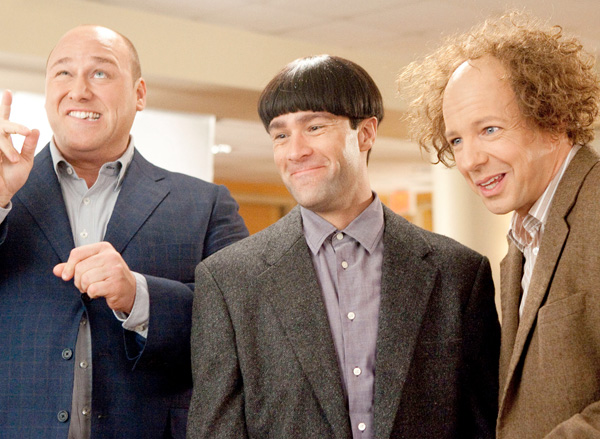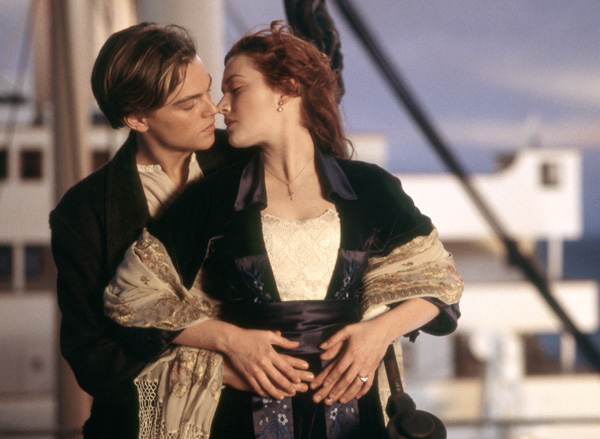
Bully
By John Mulderig, Catholic News Service
NEW YORK - With the poignant documentary "Bully" (Weinstein), filmmaker Lee Hirsch sheds light on a widespread and tenacious social problem and provides a valuable -- though not unproblematic -- starting point for important family discussions.
Hirsch reveals the victimization of a trio of teens from different parts of the country who have endured verbal and physical abuse from their peers at school. He also recounts, primarily through interviews with their grieving parents, the stories of two other students whose sufferings apparently led them to commit suicide.
Perhaps the most effective part of the movie is that which concerns a Sioux City, Iowa, seventh-grader named Alex. Wisely and effectively, Hirsch and his team simply trail Alex through his various experiences.
Thus we can hear him almost hyperventilating with dread as he prepares for the first day of a new school year. We later witness Alex's fears being cruelly fulfilled as some of the other riders on his crowded school bus hit him, strangle him, stab him with a pencil and slam his head into the high backrest of the seat ahead of him.
Awkward in manner, and stonily uncommunicative with his parents, Alex unwisely jokes with the boy sitting next to him, at one point, that they are "buddies." He's met with a sadly predictable torrent of foul-mouthed abuse.
That doomed social gambit grows out of Alex's determined conviction that his tormentors are actually his pals. Accepting the truth, of course, would mean acknowledging that he is, in fact, friendless. That's a reality of which we catch a heartrending glimpse as we see Alex engaged in one of his after-school pastimes of choice: standing alone in a vacant lot watching freight trains pull into and out of the local train yard.
Adult administrators who appear on screen seem either indifferent or impotent. Kirk Smalley, the father of an 11-year-old boy who took his own life, by contrast, has become engaged in an energetic initiative: Together with his wife Laura, he has established a consciousness-raising movement called Stand for the Silent.
Considerable debate has been provoked by the Motion Picture Association of America's original R rating for "Bully." While their detractors -- online and elsewhere -- have argued that this classification bars precisely those who would most benefit from seeing the film, the MPAA presumably applied it based on the same objective criteria they use in evaluating every other picture, regardless of its social and aesthetic worth or lack thereof.
The distributors, who originally spurned the R in favor of releasing the film as unrated, have now made the edits necessary to earn their project a PG-13, though whether some of the vocabulary still spouted by the schoolyard barbarians would be allowed to pass in other films with that rating remains open to question.
The new classification stands, in a sense, as an invitation to youthful audiences. Before allowing their teens to accept it, parents should be aware that, in addition to the small-scale brutality on display, the narrative also focuses on the fact that one of those being profiled -- a 16-year-old girl named Kelby -- is enduring persecution in her small Oklahoma hometown for being an avowed lesbian.
We see Kelby embracing the schoolmate she identifies as her girlfriend. But we also learn that she has been expelled from her church, made the target of a slow-speed hit-and-run incident and prevented from participating in the team sports she loves -- and which, she feels sure, would have earned her a college scholarship.
Accordingly, younger viewers will need sufficient maturity -- or guidance -- to distinguish between the individual rights of the homosexually oriented and a broader social agenda out of keeping with Scripture and sacred tradition. Still, after careful parental consideration, "Bully" may possibly be found, on balance, acceptable for older adolescents.
The film contains scenes of cruelty and petty violence, adult themes, including suicide and homosexuality, at least one use of the F-word and numerous crude and crass insults. The Catholic News Service classification is A-III -- adults. The Motion Picture Association of America rating is PG-13 -- parents strongly cautioned. Some material may be inappropriate for children under 13.

The Three Stooges
By Kurt Jensen, Catholic News Service
NEW YORK - A lot of shtick, a little dance, a big live lobster down someone's pants. That's about what you'd expect from an updated version of "The Three Stooges" (Fox).
Far less predictable, and most unwelcome, is the assault on the dignity of those in religious life that also characterizes this highly uneven comedy.
The inclusion of such a discordant element is all the sadder, given that the directing team of brothers Bobby and Peter Farrelly, who co-wrote the screenplay with Mike Cerrone, clearly intended their project as a sweet-natured tribute to the antics of the original performers. Moe Howard, his brother Curly, and Larry Fine are collectively much beloved for their series of theatrical shorts, later a longtime television staple for kids.
The classic physical comedy and bits of twitching business are reproduced by Chris Diamantopoulos, Sean Hayes and Will Sasso (Moe, Larry and Curly, respectively) as faithfully as if they were performing kabuki theater.
The boys are shown, in a series of three "episodes," to have grown up in an orphanage run by the Sisters of Mercy. Never having been adopted, they emerge as true adult innocents, and sally forth into the outside world intent on raising the $830,000 it will take to keep their home facility from closing.
The Stooges' mise-en-scene -- if such it may be called -- is, of course, filled with eye pokes, sledgehammer whacks and power tool-driven mayhem. So it's not really objectionable to find visiting Msgr. Ratliffe (Brian Doyle-Murray) on the receiving end of a punch ... well, a lot of punches, really. And, let it be said, he gives as good as he gets, delivering the famed triple-slap to the boys.
A sharp-tongued nun played by Larry David is also on the receiving end of a lot of head whacks. The abuse of authority figures or of people taking themselves too seriously in general is completely within the internal "Stooge logic." But a drag nun obviously propels the script a big step in the wrong direction.
What really crosses the line, however, is the highly offensive name David's character is assigned: Sister Mary-Mengele. And "she" is called that, not once or twice, but throughout the film.
A joking reference to a Nazi war criminal in a film presumably aimed at a young audience constitutes not only a cheap shot at Catholic sisters; it's a descent into tastelessness that should be deplored at all levels.
Additionally, near the end of the film, a sexualized young nun figure in a revealing swimsuit puts in a brief appearance. This is Sister Bernice, played by Kate Upton, this year's Sports Illustrated swimsuit edition cover girl. Though fleeting, such a sight gag remains queasy and unsettling.
Jane Lynch plays Mother Superior in a deadpan manner seemingly taken from the long-running stage show "Nunsense."
It's unusual for a fictional feature, particularly a comedy, to use the name of an actual religious order. But here the nuns are clearly identified as Sisters of Mercy. Turns out, that's because the Farrelly brothers have a link to the order: two aunts, it seems, are members of the community.
If referencing their congregation is meant as a shout-out to them, in this context, it's certainly not a kind one.
The film contains irreverent and occasionally offensive humor directed at clergy and religious, some crude comedy and extensive physically abusive slapstick. The Catholic News Service classification is L -- limited adult audience, films whose problematic content many adults would find troubling. The Motion Picture Association of America rating is PG -- parental guidance suggested. Some material may not be suitable for children.

Titanic
By Henry Herx, Catholic News Service
NEW YORK (CNS) - Making a spectacle of the greatest sea disaster of the century is the special effects blockbuster, "Titanic" (Paramount), now rereleased in 3-D.
Those interested in the big finish, however, will have to sit through an improbable love story long after its soggy proceedings have exhausted one's patience.
The picture begins in 1996 as a scientific expedition explores the sunken remains of the RMS Titanic using, among other things, computer graphics showing how the supposedly unsinkable ship went down.
The expedition's leader (Bill Paxton) is interested in recovering the ship's valuables, in particular a priceless diamond known to have been aboard. When he learns its owner survived and is still alive, he has the 101-year-old woman (Gloria Stuart) brought to the expedition's ship.
She is Rose DeWitt Bukater (Kate Winslet plays young Rose), who in 1912 was a 17-year-old American sailing to New York to wed her wealthy fiance, Cal Hockley (Billy Zane).
Unhappy that her mother is forcing her into this marriage, Rose climbs over the rail and contemplates suicide until saved by a sturdy youth from steerage, Jack Dawson (Leonardo DiCaprio).
Rose is intrigued by penniless Jack's boundless optimism and artistic talent when he shows her his sketches of nude Paris prostitutes.
Along the way, Rose introduces Jack to some of the famous personalities among the first-class passengers, notably Molly Brown (Kathy Bates), but this serves no greater purpose than providing the dramatic equivalent of name-dropping.
What is far more interesting than any of these characters is the plush background of the sets showing the luxurious trappings of first-class accommodations as well as the cramped, unrelieved drabness of the steerage quarters.
The friendship between the youths blossoms into an affair that begins with Rose posing for one of Jack's nude sketches, then is consummated in the back seat of an auto in the ship's hold.
This plays out as bad Edwardian melodrama with snarling villain Cal and his dour, armed retainer (Jack Warner) chasing them in and out of the bowels of the ship.
Writer-director James Cameron tries to win sympathy for the young lovers by portraying them as heroes defying the strict social conventions and moral standards of their time.
But he can't overcome the soap-opera level in which the egalitarian romance is portrayed, nor the cardboard characters of the lovers.
By the time Cameron gets to staging the sinking of the Titanic, it is indeed done on a spectacular scale, using mammoth sets and hundreds of extras. The confusion and panic of the passengers is amply displayed as the ship flounders, then breaks apart and plunges to the deep.
By focusing on the fate of the callow lovers, however, the movie fails to evoke the human dimension of this tragic loss of more than 1,500 lives in the icy waters of the North Atlantic.
In retelling an epic tragedy, "Titanic" has everything but a sense of humanity.
Because of agonizing death scenes on a massive scale, sexual situations and sporadic rough language and profanity, the Catholic News Service classification is A-III -- adults. The Motion Picture Association of America rating is PG-13 -- parents strongly cautioned. Some material may be inappropriate for children under 13.

